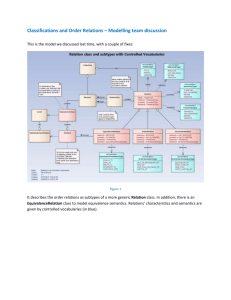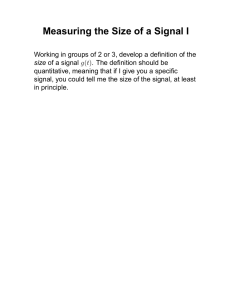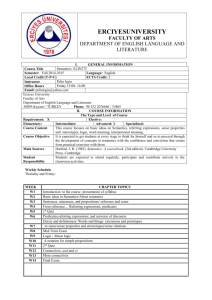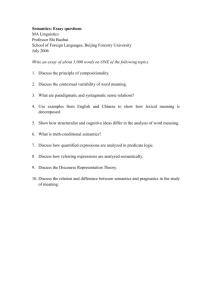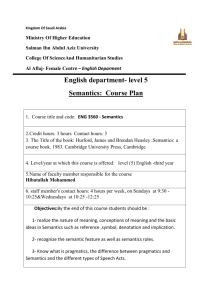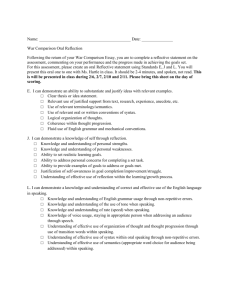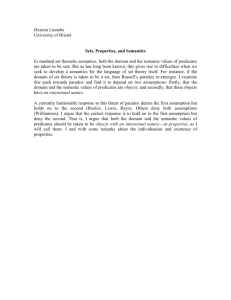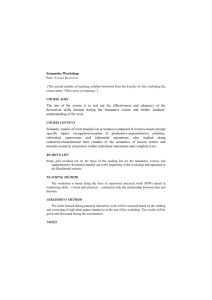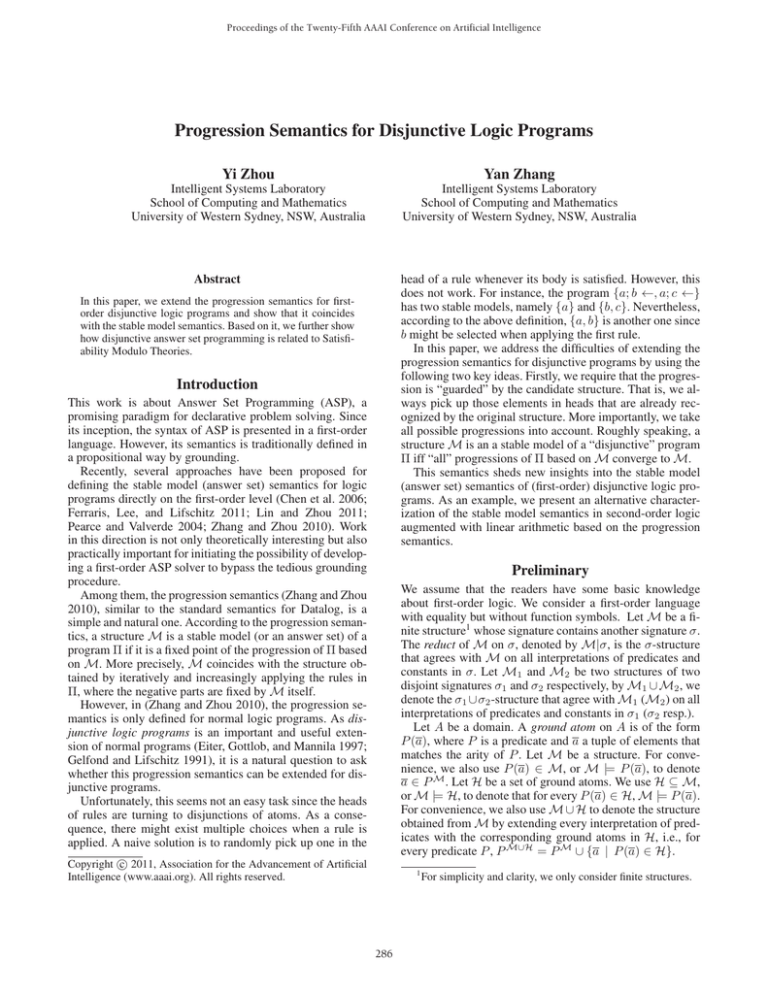
Proceedings of the Twenty-Fifth AAAI Conference on Artificial Intelligence
Progression Semantics for Disjunctive Logic Programs
Yi Zhou
Yan Zhang
Intelligent Systems Laboratory
School of Computing and Mathematics
University of Western Sydney, NSW, Australia
Intelligent Systems Laboratory
School of Computing and Mathematics
University of Western Sydney, NSW, Australia
head of a rule whenever its body is satisfied. However, this
does not work. For instance, the program {a; b ←, a; c ←}
has two stable models, namely {a} and {b, c}. Nevertheless,
according to the above definition, {a, b} is another one since
b might be selected when applying the first rule.
In this paper, we address the difficulties of extending the
progression semantics for disjunctive programs by using the
following two key ideas. Firstly, we require that the progression is “guarded” by the candidate structure. That is, we always pick up those elements in heads that are already recognized by the original structure. More importantly, we take
all possible progressions into account. Roughly speaking, a
structure M is an a stable model of a “disjunctive” program
Π iff “all” progressions of Π based on M converge to M.
This semantics sheds new insights into the stable model
(answer set) semantics of (first-order) disjunctive logic programs. As an example, we present an alternative characterization of the stable model semantics in second-order logic
augmented with linear arithmetic based on the progression
semantics.
Abstract
In this paper, we extend the progression semantics for firstorder disjunctive logic programs and show that it coincides
with the stable model semantics. Based on it, we further show
how disjunctive answer set programming is related to Satisfiability Modulo Theories.
Introduction
This work is about Answer Set Programming (ASP), a
promising paradigm for declarative problem solving. Since
its inception, the syntax of ASP is presented in a first-order
language. However, its semantics is traditionally defined in
a propositional way by grounding.
Recently, several approaches have been proposed for
defining the stable model (answer set) semantics for logic
programs directly on the first-order level (Chen et al. 2006;
Ferraris, Lee, and Lifschitz 2011; Lin and Zhou 2011;
Pearce and Valverde 2004; Zhang and Zhou 2010). Work
in this direction is not only theoretically interesting but also
practically important for initiating the possibility of developing a first-order ASP solver to bypass the tedious grounding
procedure.
Among them, the progression semantics (Zhang and Zhou
2010), similar to the standard semantics for Datalog, is a
simple and natural one. According to the progression semantics, a structure M is a stable model (or an answer set) of a
program Π if it is a fixed point of the progression of Π based
on M. More precisely, M coincides with the structure obtained by iteratively and increasingly applying the rules in
Π, where the negative parts are fixed by M itself.
However, in (Zhang and Zhou 2010), the progression semantics is only defined for normal logic programs. As disjunctive logic programs is an important and useful extension of normal programs (Eiter, Gottlob, and Mannila 1997;
Gelfond and Lifschitz 1991), it is a natural question to ask
whether this progression semantics can be extended for disjunctive programs.
Unfortunately, this seems not an easy task since the heads
of rules are turning to disjunctions of atoms. As a consequence, there might exist multiple choices when a rule is
applied. A naive solution is to randomly pick up one in the
Preliminary
We assume that the readers have some basic knowledge
about first-order logic. We consider a first-order language
with equality but without function symbols. Let M be a finite structure1 whose signature contains another signature σ.
The reduct of M on σ, denoted by M|σ, is the σ-structure
that agrees with M on all interpretations of predicates and
constants in σ. Let M1 and M2 be two structures of two
disjoint signatures σ1 and σ2 respectively, by M1 ∪ M2 , we
denote the σ1 ∪σ2 -structure that agree with M1 (M2 ) on all
interpretations of predicates and constants in σ1 (σ2 resp.).
Let A be a domain. A ground atom on A is of the form
P (a), where P is a predicate and a a tuple of elements that
matches the arity of P . Let M be a structure. For convenience, we also use P (a) ∈ M, or M |= P (a), to denote
a ∈ P M . Let H be a set of ground atoms. We use H ⊆ M,
or M |= H, to denote that for every P (a) ∈ H, M |= P (a).
For convenience, we also use M ∪ H to denote the structure
obtained from M by extending every interpretation of predicates with the corresponding ground atoms in H, i.e., for
every predicate P , P M∪H = P M ∪ {a | P (a) ∈ H}.
c 2011, Association for the Advancement of Artificial
Copyright Intelligence (www.aaai.org). All rights reserved.
1
286
For simplicity and clarity, we only consider finite structures.
where Ω∗Π < ΩΠ is the abbreviation of the formula
∀xQ∗i (x) → Qi (x) ∧ ¬
∀xQi (x) → Q∗i (x).
Syntax of disjunctive logic programs
An extended disjunctive rule (rule for short) is of the form:
α1 ; . . . ; αm ← βm+1 , . . . , βn , not γn+1 , . . . , not γk ,
(1)
not not γk+1 , . . . , not not γl ,
1≤i≤n
Definition 1 A structure M of τ (Π) is called a stable model
of Π if it is a model of SM (Π).
where 0 ≤ m ≤ n ≤ k ≤ l, αi , 1 ≤ i ≤
m is a non-equality atom, βj (m + 1 ≤ j ≤ n)
and γs (n + 1 ≤ s ≤ l) are atoms. Let r be a
rule of form (1). The head of r, denoted by Head(r),
is {α1 , . . . , αm }; the body of r, denoted by Body(r),
is {βm+1 , . . . , βn , not γn+1 , . . . , not γk , not not γk+1 , . . . ,
not not γl }. For convenience, we use P os(r) to denote
{βm+1 , . . . , βn }, the positive body of r, and N eg(r) to denote {not γn+1 , . . . , not γk , not not γk+1 , . . . , not not γl },
the negative body of r. An extended disjunctive logic program (program for short if clear from the context) is a finite
set of rules. A rule is said to be normal if m = 1 and k = l.
Then, a program is said to be normal if all the rules in it are
normal.
Here, we distinguish between intentional and extensional
predicates. A predicate P in a program Π is said to be intentional if P occurs in the head of some rules in Π, and
extensional otherwise. Let Π be a program. We use τ (Π) to
denote the signature of Π, including all predicates and constants occurring in Π. In particular, we use τext (Π) to denote
the extensional signature of Π, including all constants and
extensional predicates, and τint (Π) to denote the intentional
signature of Π, including all intentional predicates.
Note that this translational semantics is essentially the same
as the one proposed in (Ferraris, Lee, and Lifschitz 2011)
and (Lin and Zhou 2011). Here, we introduce this simplified version because we are focused on extended disjunctive
programs rather than arbitrary sentences.
Progression semantics for normal logic programs
The progression semantics for first-order normal logic programs is proposed in (Zhang and Zhou 2010), based on the
following notion of evolution stage.
Definition 2 (Evolution stage for normal programs) Let
Π be a normal program and ΩΠ = {Q1 , . . . , Qn } the set
of all intentional predicates of Π. Consider a structure M
of τ (Π). The t-th simultaneous evolution stage2 of Π based
on M, denoted as Mt (Π), is a structure of τ (Π) defined
inductively as follows:
• M0 (Π) = M|τext (Π) ∪ E|τint (Π), where E is the structure in which all interpretations of predicates are empty
set;
• Mt+1 (Π) = Mt (Π) ∪ {Head(r)η | η is an assignment,
Mt (Π) |= P os(r)η and M |= N eg(r)η}, where
Mt (Π) |= P os(r)η means that for all i, m + 1 ≤ i ≤ n,
βi η ∈ Mt (Π); M |= N eg(r)η means that for all
j, n + 1 ≤ j ≤ k, γj η ∈ M.
Translational semantics for disjunctive programs
The stable model (answer set) semantics for first-order logic
programs has been well discussed in the literature. Here, we
briefly review the translational semantics by translating to
second-order logic.
Given a program Π, let ΩΠ = {Q1 , . . . , Qn } be the set of
all intentional predicates of Π. Let Ω∗Π = {Q∗1 , . . . , Q∗n } be
a new set of predicates corresponding to ΩΠ . Given a rule r
in Π of the form (1), by r, we denote the universal closure
of the formula
The underlying intuition behind Definition 2 is quite simple. As the initial step, M0 (Π) just takes the extensional part
of M into account and set the intentional part to be empty.
Then, for each t, Mt+1 (Π) is the structure expanded from
Mt (Π) by applying the rules in Π, where the negative parts
are fixed by M. In other words, Mt+1 (Π) is expanded from
Mt (Π) by adding those heads of rules whose positive part
is satisfied by Mt (Π) and whose negative part is satisfied
by M.
βm+1 ∧ · · · ∧ βn ∧ ¬γn+1 ∧ · · · ∧ ¬γk
∧¬¬γk+1 ∧ · · · ∧ ¬¬γl → α1 ∨ · · · ∨ αm ;
by r∗ , we denote the universal closure of the formula
∗
βm+1
1≤i≤n
Definition 3 (Progression semantics for normal programs)
Let Π be a first-order normal program and M a structure
of τ (Π). M is called a stable model (or an answer set) of Π
iff M∞ (Π) = M.
βn∗
∧ ··· ∧
∧ ¬γn+1 ∧ · · · ∧ ¬γk
∗
∧¬¬γk+1 ∧ · · · ∧ ¬¬γl → α1∗ ∨ · · · ∨ αm
;
where αi∗ = Q∗ (x) if αi = Q(x) and
∗
Qj (tj ) if βi = Qj (tj ), Qj ∈ ΩΠ
βi∗ , (m+1 ≤ i ≤ n) =
βi
otherwise.
∗
we denote the first-order sentence By Π,
r∈Π r̂; by Π , we
∗
denote the first-order sentence r∈Π r .
Let Π be a program. We use SM (Π) to denote the following second-order sentence:
Definition 3 simply says that a structure is a stable model
of a program iff it is a fixed point of the progression of
the program. As shown in (Zhang and Zhou 2010), for normal programs, the progression semantics coincides with the
translational semantics.
Theorem 1 (Theorem 1, (Zhang and Zhou 2010)) Let Π
be a normal program and M a structure of τ (Π). Then, M
is a model of SM (Π) iff M∞ (Π) = M.
∧ ¬∃Ω∗Π ((Ω∗Π < ΩΠ ) ∧ Π∗ ),
Π
2
287
This is called evaluation stage in (Zhang and Zhou 2010).
0
(Π) = M|τext (Π) ∪ E|τint (Π);
• σM
Extending Progression Semantics for
Disjunctive Programs
t+1
t
• σM
(Π) = σM
(Π) ∪ Ht , where there exists Ht ⊆ M
such that it is a minimal hitting set of the collection of the
following sets:
Head(r)η,
In this section, we extend the progression semantics for disjunctive programs. Different from normal rules, the head of
a disjunctive rule is generally a set of atoms instead of a
singleton. As we mentioned in the introduction section, this
will cause problems for defining the progression semantics.
Suppose that we are now at the t-th evolution stage. The
only problem is all about how to reach the next one. Similar to the progression for normal programs (i.e. Definition
2), we will have a collection of rules which are applicable.
Hence, we will get a collection of heads of rules together
with assignments, i.e., a collection of sets of ground atoms.
The basic requirement is that for each set in the collection,
at least one element in it needs to be selected. To this end,
we recall the following notion of (minimal) hitting set.
where r is a rule in Π and η is an assignment such that
t
t
(Π) = ∅, σM
(Π) |= P os(r)η and M |=
Head(r)η ∩ σM
N eg(r)η.3
The basic idea of Definition 5 follows similarly to the evolution stage for normal programs (see Definition 2). That is,
we take the extensional structure of M as the initial input
and expand it step-by-step by applying the rules in Π. Again,
the negative parts of rules in Π are fixed by M, which is capt
(Π) |=
tured by M |= N eg(r)η in the above definition. σM
P os(r)η means that this pair of rule and assignment can be
t
(Π) = ∅
applied at the t-th stage, while Head(r)η ∩ σM
means that none of the elements in the head is derived before.
The main differences between them are threefold. Firstly,
as there are many possible progressions for a disjunctive program, we use the evolution sequence to distinguish them. Int
(Π) in Definition 5 plays a similar role of Mt (Π)
deed, σM
in Definition 2. Secondly, the new content (i.e. Ht ) added
are considered as a whole rather than rule-by-rule in Definition 2. In fact, Ht is a minimal hitting set of the collection of
heads of rules applied at the t-th stage. Finally, we require
that Ht is guarded by M, i.e., Ht ⊆ M.
Based on the notion of evolution sequence, we are able to
define our progression semantics for (first-order) disjunctive
programs.
Definition 4 (Minimal hitting set) Let S be a set and σ =
{S1 , . . . , St , . . . } a collection of sets such that for all i, Si ⊆
S. A subset H ⊆ S is said to be a hitting set of σ if for all i,
H ∩ Si = ∅. Furthermore, H is said to be a minimal hitting
set of σ if H is a hitting set of σ and there is no H ⊂ H
such that H is also a hitting set of σ.
Then, we can pick up a minimal hitting set of the collection of sets of ground atoms to continue the progression.
However, there might exist many possible minimal hitting
sets, which means that there might exist different ways to
expand the t-th structure. This shows that, for disjunctive
programs, there might exist different strategies for progression/evolution. Hence, we will need a notion of evolution
sequence to represent each possible way of progression.
Another issue is that, the minimal hitting set selected
above might beyond the scope the original structure. Recall
the simple example mentioned in the introduction section,
which consists of two rules: a; b ← and a; c ←. Now suppose that the candidate structure is {a}. At the first evolution step, both the two rules are applicable. Then, we have a
collection of atoms, namely {{a, b}, {a, c}}, which has two
minimal hitting sets, namely {a} and {b, c}. The former is
an appropriate choice and it actually shows that {a} is a stable model of the program. However, the latter is not recognized by the original structure (i.e. {a}). If chosen, then
the progression will never converge to the the structure {a},
which means that this progression is failed.
To address this issue, we require that each progression
step must be “guarded” by the original structure in the sense
that each minimal hitting set selected must be recognized
by the original structure. That is, in every progression step,
if we want to expand the structure to the next one, the new
content must be already in the original structure.
The key definition of evolution sequence for our progression semantics is defined as follows.
Definition 6 (Progression semantics) Let Π be a (disjunctive) program and M a structure of τ (Π). M is called a
stable model (or an answer set) of Π iff there exists at least
one evolution sequence, and for all evolution sequence σ of
∞
(Π) = M.
Π based on M, σM
Two programs are said to be equivalent if they have the same
set of stable models.
Again, similar to Definition 3, we require that the progression converges to the original structure. That is, M is
a fixed point of the progression. However, the main difference is that we require this is the case “for all” possible progressions. Restricted to normal programs, this definition coincides with Definition 3 as normal programs only have a
unique sequence of evolution/progression.
One may wonder whether this “for all” condition can
be someway modified into a “there exists” condition. Most
likely, this is not the case. Evident from (Eiter, Gottlob, and
Mannila 1997), disjunctive logic programs under the stable
model semantics is more expressive than normal programs,
providing some general assumptions in the computational
complexity theory. Definition 6 provides another explanation where the gap between disjunctive ASP and normal
ASP lies.
Definition 5 (Evolution sequence) Let Π be a program
and M a structure of τ (Π). Let ΩΠ = {Q1 , . . . , Qn } be
the set of all intentional predicates of Π. An evolution sequence of Π based on M, denoted as σM (Π), is a se0
1
t
(Π), σM
(Π), . . . , σM
(Π), . . . of structures of
quence σM
τ (Π) such that
3
Note that we allow double negation-as-failure in the bodies.
Nevertheless, the meaning of M |= N eg(r)η is clear here, which
requires additionally that for all i, k + 1 ≤ i ≤ l, ri η ∈ M.
288
1. for every assignment η and every rule r of form (1) in Π,
if M |= Body(r)η, then M |= Head(r)η.
Example 1 [originated from Example 2 in (Eiter, Gottlob,
and Mannila 1997)] Consider the following program Π0 :
R(x); G(x); B(x) ←
N otColored ← R(x), R(y), E(x, y)
N otColored ← G(x), G(y), E(x, y)
N otColored ← B(x), B(y), E(x, y)
R(x) ← N otColored
G(x) ← N otColored
B(x) ← N otColored
N otColored ← not N otColored
(2)
(3)
(4)
(5)
(6)
(7)
(8)
(9)
2. there does not exist a structure M of τ (Π) such that
(a) Dom(M ) = Dom(M),
(b) for each constant c in τ (Π), cM = cM ,
(c) for each P ∈ τext (Π), P M = P M ,
(d) for all Q ∈ τint (Π), QM ⊆ QM , and for some Q ∈
τint (Π), QM ⊂ QM ,
(e) for every assignment η and every rule r of form (1)
in Π, if M |= P os(r)η and M |= N eg(r)η, then
M |= Head(r)η.
E is the only extensional predicates of Π0 , which, ideally,
represents the edges of a graph; R, G and B are three unary
intentional predicates, which denote three colors red, green
and blue respectively; N otColored is a 0-ary intentional
predicate to state that the graph is not 3-colorable. In fact,
Π0 is the program for 3-uncolorability. That is, if a graph,
represented by E, is not 3-colorable, then Π0 has a unique
stable model, in which all intentional predicates are interpreted as full relation on the domain. On the other hand, if a
graph is 3-colorable, then Π0 has no stable models.
First of all, if Π has a stable model, it must contain
N otColored and the full relation for R, G and B. This is because by rule (9), N otColored must be in the stable model,
and then by rules (6)-(8), all R, G and B will be derived.
Now we analyze Π0 by using the progression semantics.
Suppose that a graph, represented by E, is not 3-colorable.
Consider the structure A containing E, N otColored and
RA = GA = B A = Dom(A). Then, at the first stage,
rule (2) is the only applicable one, and each minimal hitting
set actually corresponds to a possible color mapping. In fact,
there might exist many different mappings thus many different evolution sequences. Since the graph is not 3-colorable,
no matter which evolution sequence is selected, there must
exist a rule among (3)-(5) which is applicable at the second
stage. Hence, N otColored must be derived. Therefore, all
R, G and B will be derived at the third stage according to
rules (6)-(8). Hence, A is a stable model of Π0 if the graph
is not 3-colorable. In addition, it is the unique one.
Suppose that the graph is 3-colorable. For the structure
B containing E, N otColored and RB = GB = B B =
Dom(B), we can construct an evolution sequence which
does not converges to B by simply select the minimal hitting set that corresponds to the 3-coloring solution at the first
stage. Therefore, Π0 has no stable models in this case.
In general, we present the following main theorem.
Theorem 2 Let Π be a program and M a structure of τ (Π).
Then, M is a model of SM (Π) iff there exists and for every
∞
evolution sequence σ of Π based on M, σM
(Π) = M.
This semantics coincides with the translational semantics
and Condition 2 does
because Condition 1 holds iff M |= Π,
not hold iff M |= ∃Ω∗Π ((Ω∗Π < ΩΠ ) ∧ Π∗ ).
Now we show that this semantics also coincides with the
progression semantics. On one hand, suppose that for ev∞
(Π) =
ery evolution sequence σ of Π based on M, σM
M. Then, Condition 1 holds. Otherwise, there exists a pair
(r, η) violating Condition 1. Hence, M |= Body(r)η but
M |= Head(r)η. Consider an evolution sequence σ. We
∞
(Π). Thus, there exists a number t such
have M = σM
t+1
t
t
that σM (Π) |= Body(r)η. Then, σM
(Π) = σM
(Π) ∪ Ht .
t
Hence, H |= Head(r)η according to the definition. Since
t+1
∞
H t ⊆ σM
(Π) ⊆ σM
(Π) = M, M |= Head(r)η as
well, a contradiction. In addition, Condition 2 must hold as
well. Otherwise, let us assume that there exists such an M .
We construct an evolution sequence σ in the same way as in
Definition 5 except that we require additionally Ht ⊆ M .
This evolution sequence is well defined because M satisfies Condition 2, particularly Condition 2(e). Now, by induction on the evolution stage t, it can be shown that for
t
∞
(Π) ⊆ M . Therefore, σM
(Π) ⊆ M ⊂ M, a
all t, σM
contradiction.
On the other hand, suppose that a structure M satisfies
both Conditions 1 and 2. Then, it can be shown that for
t
(Π) ⊆ M by induction on
every evolution sequence σ, σM
∞
(Π) ⊆ M.
the evolution stage t by Condition 1. Hence, σM
∞
Now we prove that for any σ, σM (Π) ⊂ M. Otherwise,
we construct a structure M of τ (Π) in the following way:
Dom(M ) = Dom(M), for each constant c ∈ τ (Π),
cM = cM , for each extensional predicate P ∈ τext (Π),
P M = P M , and finally, for each intentional predicate
∞
Q ∈ ΩΠ , QM = QσM (Π) . It can be checked that M
satisfies Conditions 2(a)-(e) as well, a contradiction. This
∞
(Π) = M. shows that for any σ, σM
Proof:(sketch)4 In order to prove this theorem, we introduce
an intermediate semantics and show that it is equivalent to
both semantics described above.
Let Π be a program and M a structure of τ (Π). We say
that M is a stable model of Π iff
A relate work to our progression semantics is due to
Minker and Rajasekar (1990), who proposed a fixed point
for disjunctive logic programs and showed that it coincides
with the minimal model semantics. Different from ours, their
definition is defined on so-called extended Herbrand structures but not on arbitrary structures. Also, its relationship to
stable model semantics remains unknown.
4
The proofs in this paper, if given, are sketched due to a space
limit.
289
From Disjunctive ASP to SMT
The following proposition indicates the correspondence
between evolution sequences and valid level mappings.
Proposition 1 An evolution sequence σ yields a valid level
mapping f , in which all ground atoms are mapped into
its level in σ, i.e., f (P (a)) = k, where k is the level of
P (a) in σ. Conversely, a valid level mapping f can be converted back to an evolution sequence σ by grouping the
ground atoms at the same level together as the expanded
k+1
k
(Π) = σM
(Π) ∪ Hk , where Hk =
ground atoms, i.e., σM
{P (a) | f (P (a)) = k}.
Proof:(sketch) “⇒:” Condition 1 holds obviously since
∞
Ht ⊆ M, thus σM
(Π) ⊆ M. For Condition 2, if M |=
Body(r)η and for all Q(a) ∈ Head(r)η, f (Q(a)) >
max(P os(r)η), then (r, η) is applicable at some stage t in
σ. Hence, there exists Q(a) ∈ Head(r)η selected at this
stage, i.e., Q(a) ∈ Ht . Thus, f (Q(a)) = max(P os(r)η) +
1. Condition 2 holds. Finally, for Condition 3, if f (Q(a)) =
∞, then Q(a) must be selected at some stage t in σ with respect to a pair (r, η). Hence, f (Q(a)) = max(P os(r)η)+1.
In addition, for all other R(b) ∈ Head(r)η, f (R(b)) >
f (Q(a)) since none of the other elements in Head(r)η is
derived before. This shows that Condition 3 holds as well.
“⇐:” It suffices to show that for all k, Hk is the minimal
hitting set of the collection {Head(r)η} meeting the
requirements. This can be proved by induction on k. It
holds obviously when k = 0. Consider the t-th stage.
Condition 1 implies that Ht ⊆ M. In addition, if a pair
(r, η) is applicable, then Condition 2 applies under the
induction hypothesis. Therefore, Head(r)η ∩ Ht = ∅.
Finally, Condition 3 ensures that Ht is actually minimal
since every Q(a) in Ht must be selected with respect to a
pair (r, η) at this stage. In this section, we consider an application of the progressions semantics to relate Disjunctive ASP and Satisfiability Modulo Theories (SMT), which are logical theories augmented with some background theories (Nieuwenhuis, Oliveras, and Tinelli 2006). More precisely, we show that the stable model semantics for (first-order) disjunctive logic programs can be characterized alternatively in second-order
logic augmented with linear arithmetics.
Recall Definition 5 for evolution sequence. The sequence
of structures is constructed inductively. Then, for every in∞
tentional ground atom P (a) ∈ σM
(Π), there exists a minik
mal number k such that P (a) ∈ σM
(Π). We call k the level
∞
(Π), we treat its level as
of P (a) in σ. For those P (a) ∈ σM
∞.5 This motives us to consider a notion of level mapping
for ground atoms as follows.
Definition 7 (Level mapping) Let Π be a program and M
a finite structure of τ (Π). A level mapping of M on Π is a
function f from all intentional ground atoms to the natural
numbers, i.e. f : {P (a) | P ∈ τint (Π), a ∈ Dom(M)} →
N. In addition, we say that f is complete if
f (P (a)) = ∞ iff P (a) ∈ M;
we say that f is valid if
1. for all P (a) ∈ M, f (P (a)) = ∞;
2. for every pair (r, η) of rule and assignment, if M |=
Body(r)η and for all Q(a) ∈ Head(r)η, f (Q(a)) >
max(P os(r)η),6 then there exists Q(a) ∈ Head(r)η
such that f (Q(a)) = max(P os(r)η) + 1.
3. for every Q(a) such that f (Q(a)) = ∞, there exists
a pair (r, η) of rule and assignment such that Q(a) ∈
Head(r)η, f (Q(a)) = max(P os(r)η) + 1 and for all
other R(b) ∈ Head(r)η, f (R(b)) > f (Q(a)).
Intuitively, a level mapping represents the minimal steps
to derive all intentional ground atoms in M by iteratively applying rules in Π. It is complete if consistent with the structure M. That is, all intentional ground atoms in M can be
derived and those not in M cannot (i.e. its level is ∞). It is
valid if corresponding to an evolution sequence. Condition
1 means that all intentional ground atoms not in M cannot
be derived. Condition 2 means that every applicable rule (together with an assignment) should be used. M |= Body(r)η
means that the rule r is applicable, and max(P os(r)η) represents its stage. The if-then condition means that if none of
the elements in the head is not derived before, then at least
one of them must be derived at this stage. Finally, Condition
3 is a reverse condition of Condition 2, meaning that every
derivable ground atom must be justified by a particular pair
of rule and assignment, which is used to derive this atom.
Here, f (R(b)) > f (Q(a)) means that the other atoms in the
head are derived neither before nor at this stage.
Furthermore, the following proposition shows that an evolution sequence converges to the original structure iff its corresponding level mapping is complete.
Proposition 2 Let σ be an evolution sequence and f its cor∞
(Π) = M iff f is comresponding level mapping. Then, σM
plete.
Based on the above observations, we can reformulate the
progression semantics for (first-order) disjunctive programs
on finite structures to second-order logic augmented with
linear arithmetic, similar to SMT. To this end, we need
to introduce a set of function variables7 to represent the
level mapping. More precisely, let ΩΠ = {Q1 , . . . , Qn }
be the set of intentional predicates in Π, we introduce a set
FΠ = {fQ1 , . . . , fQn } of function variables, where fQi has
the same arity as Qi . Ideally, FΠ is used to simulate a level
mapping in the sense that f (Qi (t)η) (i.e. the level mapping
of a ground atom Qi (t)η) is represented as fQi (t)η in the
language.
Theorem 3 Let Π be a program and M a finite structure of
τ (Π). Then, M is a stable model of Π iff it is a model of the
following sentence:
∃FΠ (V F (Π) ∧ CF (Π)) ∧ ∀FΠ (V F (Π) → CF (Π)), (10)
Here, we use the notation ∞ for clarity and more readability.
Technically, we can use an arbitrarily large integer instead.
6
For simplicity, by given a set S of atoms, we use max(S)
(min(S) resp.) to denote the maximal (minimal) number of
{fP (t) | P (t) ∈ S}. In particular, if S contains no intentional
predicates, we treat this maximum as 0.
5
7
An n-ary function variable in second-order logic can be reformulated as an n + 1-ary predicate variable in a standard way.
290
where V F (Π) is the conjunction of the following formulas
∀x(¬P (x) → [fP (x) = ∞]),
(11)
P ∈ΩΠ
→
∀y(Body(r)
r∈Π
ASP to difference logic (Niemelä 2008) in the sense that it
uses an alternative encoding. We leave the detailed comparisons about related work to our full version.
Conclusions
Q(x) ∧
In this paper, we extended the progression semantics for
(first-order) disjunctive logic programs and showed that it
coincides with the translational stable model semantics (see
Theorem 2). This semantics sheds new insights into disjunctive answer set programming. According to the progression
semantics, one can conclude that:
disjunctive answer set programming
= rules + negation-as-failure + disjunctive heads (syntactic)
= progression + fixed point + minimal hitting set (semantic)
In contrast, Datalog corresponds to the first component and
normal ASP corresponds to the first two, both from a syntactic and a semantic point of view.
Based on the progression semantics, we presented another
equivalent characterization of the stable model semantics
(see Theorem 3). We believe that this new characterization is
not only of theoretical interests but also useful for developing more sophisticated solvers for disjunctive ASP. We leave
this as one of our future investigations. Another work worth
pursuing is to further extend the progression semantics for
arbitrary sentence-like programs, particularly for handling
existential quantifiers.
Q(x)∈Head(r)
[min(Head(r)) ≤ max(P os(r)) + 1]), (12)
∀x([fQ (x) = ∞] →
Q∈ΩΠ
r∈Π,Q(x)∈Head(r)
∧ [fQ (x) = max(P os(r)) + 1]
∃y(Body(r)
(13)
∧[fQ (x) < min(Head(r)\Q(x))])),
and CF (Π) is the following formula
∀x(P (x) ↔ [fP (x) = ∞]).
(14)
P ∈ΩΠ
Proof:(sketch) This assertion follows from Proposition 1,
Proposition 2 and Definition 6 by noticing that a structure
M of the signature τ (Π) ∪ FΠ is a model of V F (Π) iff the
level mapping f , obtained by f (Q(a)) = fQ (a), is valid;
M is a model of CF (Π) iff f is complete. The underlying intuitions behind Theorem 3 are quite
clear. Above all, formula (10) precisely encodes the progression semantics (see Definition 6). That is, a structure is a stable model of a program iff “there exists” and “for all” evolution sequences (formulated by valid level mappings according to Proposition 1), the resulting structure coincides with
the original one (formulated by complete level mappings).
Here, CF (Π) means that FΠ represents a complete level
mapping, while V F (Π) means that FΠ represents a valid
level mapping. In particular, Formulas (11)-(13) exactly correspond to Conditions 1-3 in Definition 7 respectively.
By restricting Theorem 3 to the propositional case, we can
get a translation from propositional disjunctive ASP to quantified Satisfiability Modulo Theories (SMT), where quantifiers may be used over arithmetical variables. This points
out the possibility to develop a new kind of disjunctive ASP
solver by using a QBF-like solver with some techniques for
handling linear constraints. We believe this is a promising
approach and leave this to our future investigations.
Also, it is worth mentioning that Theorem 3, restricted
to normal logic programs, yields a translation from normal
ASP to first-order SMT on finite structures since normal programs only have a unique evolution sequence (i.e. valid level
mapping). More precisely, a finite structure M is a stable
model of a normal program Π if it is a model of the formula
References
Asuncion, V.; Lin, F.; Zhang, Y.; and Zhou, Y. 2010. Ordered completion for first-order logic programs on finite
structures. In AAAI, 249–254.
Chen, Y.; Lin, F.; Wang, Y.; and Zhang, M. 2006. First-order
loop formulas for normal logic programs. In KR, 298–307.
Eiter, T.; Gottlob, G.; and Mannila, H. 1997. Disjunctive
datalog. ACM Trans. Database Syst. 22(3):364–418.
Ferraris, P.; Lee, J.; and Lifschitz, V. 2011. Stable models
and circumscription. Artif. Intell. 175(1):236–263.
Gelfond, M., and Lifschitz, V. 1991. Classical negation in
logic programs and disjunctive databases. New Generation
Comput. 9(3/4):365–386.
Lin, F., and Zhou, Y. 2011. From answer set logic programming to circumscription via logic of GK. Artif. Intell.
175(1):264–277.
Minker, J., and Rajasekar, A. 1990. A fixpoint semantics for
disjunctive logic programs. J. Log. Program. 9(1):45–74.
Niemelä, I. 2008. Stable models and difference logic. Ann.
Math. Artif. Intell. 53(1-4):313–329.
Nieuwenhuis, R.; Oliveras, A.; and Tinelli, C. 2006. Solving SAT and SAT modulo theories: From an abstract DavisPutnam-Logemann-Loveland procedure to DPLL(T). J.
ACM 53(6):937–977.
Pearce, D., and Valverde, A. 2004. Towards a first order
equilibrium logic for nonmonotonic reasoning. In JELIA,
147–160.
Zhang, Y., and Zhou, Y. 2010. On the progression semantics
and boundedness of answer set programs. In KR, 518–526.
∃FΠ (V F (Π) ∧ CF (Π)),
or equivalently, it is a reduct of the formula V F (Π)∧CF (Π)
on τ (Π). A similar work is proposed recently (Asuncion et
al. 2010), whose host language is classical first-order logic
instead of first-order SMT. By further restricting this result to the propositional case, we can get a translation from
propositional normal ASP to propositional SMT. This result
is actually different from Niemela’s translation from normal
291


